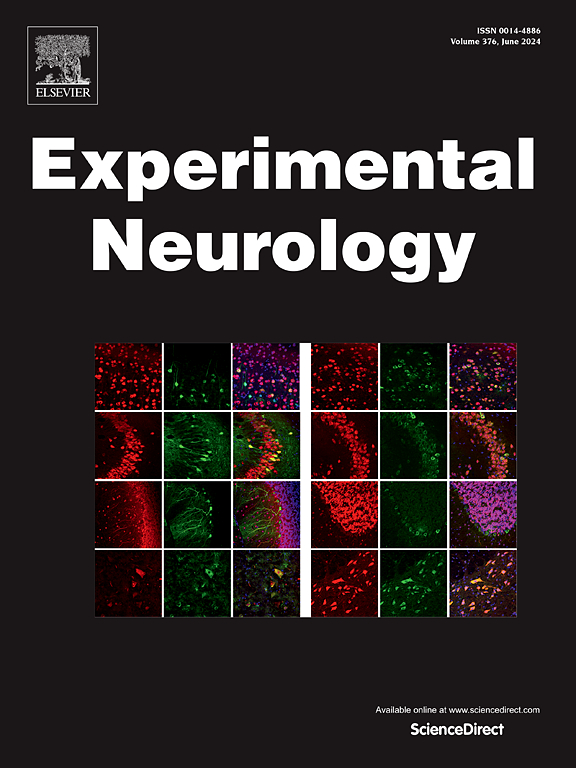The emerging role of the microglia triggering receptor expressed on myeloid cells (TREM) 2 in multiple sclerosis
IF 4.6
2区 医学
Q1 NEUROSCIENCES
引用次数: 0
Abstract
Background
The chronic inflammatory condition known as multiple sclerosis (MS) causes inflammation and demyelination in the central nervous system (CNS). The activation of multiple cell types, including the CNS's resident immune cells called microglia, is a component of the immunological response in MS. Recently, the triggering receptor expressed on myeloid cells (TREM) family has emerged as a crucial player in modulating microglial function and subsequent neuroinflammation. Understanding the role of TREM receptors in MS pathogenesis could provide insightful information on how to develop new therapeutic approaches.
Main body
The TREM family consists of several receptors, including TREM-1 and TREM-2, which can be expressed on both immune cells, such as myeloid cells and microglia, and non-immune cells. These receptors interact with their respective ligands and regulate signaling pathways, ultimately leading to the control of microglial activation and inflammatory reactions. TREM-2, in particular, has garnered significant interest because of its connection with MS and other neurodegenerative diseases. The activation of microglia through TREM receptors in MS is thought to influence the equilibrium between helpful and detrimental inflammatory responses. TREM receptors can promote the phagocytosis of myelin debris and remove apoptotic cells, thus contributing to tissue repair and regeneration. However, excessive or dysregulated activation of microglia mediated by TREM receptors can lead to the release of pro-inflammatory cytokines and neurotoxic factors, exacerbating neuroinflammation and neurodegeneration in MS.
Conclusion
The emerging role of the TREM family in demyelinating diseases highlights the importance of microglia in disease pathogenesis. Understanding the mechanisms by which TREM receptors modulate microglial function can provide valuable insights into the development of targeted therapies for these disorders. By selectively targeting TREM receptors, it may be possible to harness their beneficial effects on tissue repair while dampening their detrimental pro-inflammatory responses. Further research is warranted to elucidate the precise signaling pathways and ligand interactions involved in TREM-mediated microglial activation, which could uncover novel therapeutic avenues for treating MS and other neuroinflammatory disorders.
髓系细胞上表达的小胶质细胞触发受体(TREM)2 在多发性硬化症中的新作用。
背景:多发性硬化症(MS)这种慢性炎症会导致中枢神经系统(CNS)发炎和脱髓鞘。包括中枢神经系统常驻免疫细胞小胶质细胞在内的多种细胞类型的激活是多发性硬化症免疫反应的一个组成部分。最近,髓系细胞上表达的触发受体(TREM)家族已成为调节小胶质细胞功能和随后神经炎症的关键角色。了解 TREM 受体在多发性硬化症发病机制中的作用可为开发新的治疗方法提供有见地的信息:TREM家族由几种受体组成,包括TREM-1和TREM-2,它们既可在免疫细胞(如骨髓细胞和小胶质细胞)上表达,也可在非免疫细胞上表达。这些受体与各自的配体相互作用并调节信号通路,最终导致对小胶质细胞活化和炎症反应的控制。由于 TREM-2 与多发性硬化症和其他神经退行性疾病有关,它尤其引起了人们的极大兴趣。在多发性硬化症中,通过 TREM 受体激活小胶质细胞被认为会影响有益和有害炎症反应之间的平衡。TREM 受体可以促进髓鞘碎片的吞噬,清除凋亡细胞,从而促进组织修复和再生。然而,TREM受体介导的小胶质细胞过度或失调激活可导致促炎细胞因子和神经毒性因子的释放,加剧多发性硬化症的神经炎症和神经退行性变:TREM家族在脱髓鞘疾病中新出现的作用凸显了小胶质细胞在疾病发病机制中的重要性。了解 TREM 受体调节小胶质细胞功能的机制可为开发治疗这些疾病的靶向疗法提供有价值的见解。通过选择性地靶向 TREM 受体,也许可以利用其对组织修复的有益作用,同时抑制其有害的促炎反应。我们需要进一步研究阐明 TREM 介导的小胶质细胞活化所涉及的精确信号通路和配体相互作用,从而发现治疗多发性硬化症和其他神经炎症性疾病的新疗法途径。
本文章由计算机程序翻译,如有差异,请以英文原文为准。
求助全文
约1分钟内获得全文
求助全文
来源期刊

Experimental Neurology
医学-神经科学
CiteScore
10.10
自引率
3.80%
发文量
258
审稿时长
42 days
期刊介绍:
Experimental Neurology, a Journal of Neuroscience Research, publishes original research in neuroscience with a particular emphasis on novel findings in neural development, regeneration, plasticity and transplantation. The journal has focused on research concerning basic mechanisms underlying neurological disorders.
 求助内容:
求助内容: 应助结果提醒方式:
应助结果提醒方式:


